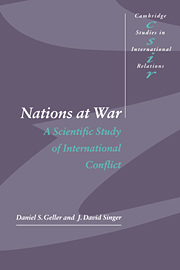Book contents
- Frontmatter
- Contents
- List of figures and tables
- Acknowledgements
- Introduction
- 1 Overview
- 2 Decision models
- 3 War-prone states
- 4 War-prone dyads
- 5 War-prone regions
- 6 War-prone systems
- 7 Case study: Iran/Iraq War (1980)
- 8 Case study: World War I (1914)
- 9 Conclusion
- Appendix 1 List of databases
- Appendix 2 Tables of references by category
- References
- Index
- Cambridge Studies in International Relations
4 - War-prone dyads
Published online by Cambridge University Press: 16 October 2009
- Frontmatter
- Contents
- List of figures and tables
- Acknowledgements
- Introduction
- 1 Overview
- 2 Decision models
- 3 War-prone states
- 4 War-prone dyads
- 5 War-prone regions
- 6 War-prone systems
- 7 Case study: Iran/Iraq War (1980)
- 8 Case study: World War I (1914)
- 9 Conclusion
- Appendix 1 List of databases
- Appendix 2 Tables of references by category
- References
- Index
- Cambridge Studies in International Relations
Summary
Introduction
This chapter examines quantitative empirical research that relates to patterns of foreign conflict and war at the level of the dyad (references listed in appendix 2, table A.2). Seven general categories of predictors are discussed in terms of the war-proneness of nation-pairs. Some of these factors have a substantial history in realist explanations on the causes of war (e.g., capability differentials, alliances, and arms races), while others have constituted cornerstones of liberal philosophy as elements associated with peaceful interstate relations (e.g., economic development, free trade, and democracy). Dyadic-level theory is more fully specified and elaborate than theory at the state level and as a result much of the current research in international politics is conducted at this level of analysis. In addition to the factors mentioned above, other elements included in this chapter that are postulated to affect the conflict patterns of nation-dyads include the proximity or actual contiguity of states, and the basic orientation toward the status quo as either challenger or defender. It should be noted that explanations regarding the effects of many of these factors utilize some form of decisionmaking theory (e.g., expected-utility theory) as discussed in chapter 2. However, as in chapter 3, the compilation and review of evidence will be limited to empirical associations between characteristics of dyads and their patterns of foreign conflict and war.
Capability balance
The relationship between capability distributions and war is a recurring theme in the literature on international relations.
- Type
- Chapter
- Information
- Nations at WarA Scientific Study of International Conflict, pp. 68 - 96Publisher: Cambridge University PressPrint publication year: 1998
- 1
- Cited by



